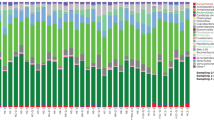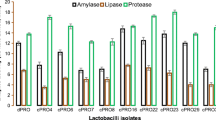Abstract
The effects of non-authochtonous Enterococcus faecium AL41 = CCM 8558, enterocin M-producing and probiotic strain were tested on the microbiota, phagocytic activity, hydrolytic enzymes, biochemical parameters and dry matter in horses based on its previous benefits demonstrated in other animals. E. faecium CCM 8558 sufficiently colonized the digestive tract of horses. At day 14, its counts reached 2.35 ± 0.70 CFU/g (log 10) on average. The identity of CCM 8558 was confirmed by means of PCR after its re-isolation from horse faeces. The inhibition activity of CCM 8558 was demonstrated against Gram-negative aeromonads, counts of which were significantly reduced (P < 0.001). After 14 days application of CCM 8558, a tendency towards increased phagocytic activity (PA) was measured; PA value was 73.13% ± 8.55 on average at day 0/1; at day 14, it was 75.11 ± 8.66%. Cellulolytic, xylanolytic and pectinolytic activity in horse faeces was significantly increased (P < 0.001) at day 14 (after CCM 8558 application) and amylolytic activity as well (P < 0.01) compared to day 0/1. Inulolytic activity increased with mathematical difference 1.378. Dry matter value reached 20.81 ± 2.29% on average at day 0/1; at day 14, it was 20.77 ± 2.59% (P = 0.9725). Biochemical parameters were influenced mostly in the physiological range. These results achieved after application of CCM 8558 in horses are original, giving us further opportunity to continue these studies, to measure additional parameters and to show the benefits of CCM 8558 application in horses.
Similar content being viewed by others
Availability of Data and Material
The datasets used and/or analysed during the current study are available from the corresponding author upon reasonable request.
Abbreviations
- CFU:
-
colony-forming unit
- log 10:
-
logarithmic 10
- g:
-
gram
- %:
-
percentage
- van gene:
-
vancomycin gene
- CCM:
-
Culture Collection of Microorganisms
- log cycle:
-
logarithmic growth phase
- E:
-
Enterococcus
- μmoL/g/DM/min:
-
micromol per gram of dry matter per minute
- TP:
-
total protein
References
Garret LA, Brown R, Poxton IR (2002) A comparative study of the intestinal microbiota of healthy horses and those suffering from equine grass sickness. Vet Microbiol 87:81–88
Lauková A, Várady M (2011) Gram-negative microbiota from horses and their sensitivity to antimicrobials, phyto-additives and enterocins. Folia Vet 55:137–143 ISSN 0015-5748
Al Jassim RA, Andrews FM (2009) The bacterial community of the horse gastrointestinal tract and its relation to fermentative acidosis, laminitis, colic, and stomach ulcers. Vet Clin North Am Equine Pract 25:199–215
Schoster A, Weese JS, Guardabassi L (2014) Probiotic use in horses-what is the evidence for their clinica efficacy? J Vet Intern Med 28:1640–1652
Dougal K, de la Fuente G, Harris PA, Girdwood SE, Pinloche E, Newbold CJ (2013) Identification of a core bacterial community within the large intestine of the horse. PLoS One 8:e77660
Weese JS, Baird JD, Poppe J, Archambault C (2001) Emergence of Salmonella Typhimurium definitive type 104 (DT104) as an important cause of salmonellosis in horses in Ontario. Can Vet 42:788–791
Lavoié JP, Drolet R, Parsons D, Laguillette R, Sauvageau R, Shapiro J, Houle L, Hallé G, Gebhart CJ (2000) Equine proliferative enteropathy: a cause of weight loss, colic, diarrhoea and hypoproteinaemia in foals on three breeding farms in Canada. Equine Vet J 32:418–425. https://doi.org/10.2746/042516400777591110
Tirosh-Levy S, Blum SE, Steward KF, Waller AS, Steinman A (2016) Streptococcus equi subspecies equi in horses in Israel: seroprevalence and strain types. Vet Rec Open 3:e000187. https://doi.org/10.1136/vetreco-2016-000187
Franz CHMAP, van Belkum MJ, Holzapfel WH, Abriouel H, Gálvéz A (2007) Diversity of enterococcal bacteriocins and their grouping in a new classification scheme. FEMS Microbiol Rev 31:293–307. https://doi.org/10.1111/j.1574-6976.2007.00064.x
Lauková A, Simonová M, Strompfová V, Štyriak I, Ouwehand AC, Várady M (2008) Potential of enterococci isolated from horses. Anaerobe 14:234–236. https://doi.org/10.1016/j.anaerobe.2008.04.002
Mareková M, Lauková A, Skaugen M, Nes IF (2007) Isolation and characterization of a new bacteriocin, termed enterocin M, produced by environmental isolate Enterococcus faecium AL41. J Ind Microbiol Biotechnol 34:533–537. https://doi.org/10.1007/s10295-007-0226-4
Lauková A, Chrastinová Ľ, Pogány Simonová M, Strompfová V, Plachá I, Čobanová K, Formelová Z, Chrenková M, Ondruška Ľ (2012) Enterococcus faecium AL41: its enterocin M and their beneficial use in rabbits husbandry. Prob Antimicro Prot 2012(4):243–249. https://doi.org/10.1007/s12602-012-9118-7
Lauková A, Strompfová V, Plachá I, Čobanová K, Faix Š, Pogány Simonová M (2015a) Beneficial effect of enterocin M-producing, probiotic strain Enterococcus faecium AL41 in model experiment with hens. Global J Anim Sci Res 3:206–213. ISSN:2345–4385
Lauková A, Kandričáková A, Ščerbová J (2015b) Use of bacteriocin-producing, probiotic strain Enterococcus faecium AL41 to control intestinal microbiota in farm ostriches. Lett Appl Microbiol 60:531–535. https://doi.org/10.1111/lam.12409
Lauková A, Styková E, Kubašová I, Gancarčíková S, Plachá I, Mudroňová D, Kandričáková A, Miltko R, Belzecki G, Valocký I, Strompfová V (2018) Enterocin M and its beneficial effects in horses-pilot experiment. Prob Antimicrob Proteins 10:420–426. https://doi.org/10.1007/s12602-018-9390-2
Lauková A, Strompfová V, Ouwehand A (2004) Adhesion properties of enterococci to intestinal mucus of different hosts. Vet Res Commun 28:647–655
Woodford N, Engelton MC, Morrison D (1997) Comparison of PCR with phenotypic methods for the speciation of enterococci. Adv Exp Med 418:405–408
Lauková A, Strompfová V, Szabóová R, Bónai A, Matics ZS, Kovács M, Pogány Simonová M (2019) Enterococci from Pannon White rabbits: detection, identification, biofilm and screening for virulence factors. World Rab Sci 27:31–39
Vetvička V, Farnousek L, Kopeček J, Kaminková J, Kašpárek L, Vránová M (1982) Phagocytosis of human blood leucocytes, a simple micromethod. Immunol Lett 5:97–100
Huhtanen P, Khali H (1992) The effect of sucrose supplements on particle-associated carboxymethylcellulase (EC 3.2.1.4) and xylanase (EC 3.2.1.8) activities in cattle given grass-silage based diet. Br J Nutr 67:245–255
Miltko R, Belzecki G, Kowalik B, Skomial J (2016) Presence of carbohydrate-digesting enzymes throughout the digestive tract of sheep. Tur J Vet Anim Sci 40:271–277. https://doi.org/10.3906/vet-1507-70
Costa MC, Arroyo LG, Allen-Vercoe E, Stämpli HR, Kim PT, Sturgeon A, Weese JS (2012) Comparison of the fecal microbiota of healthy horse and horses with colitis by high throughput sequencing of the V3-V5 region of the 16S rRNA gene. PLoS One 7:e41484
Bino E, Lauková A, Micenková L, Kubašová I, Kandričáková A, Plachá I, Strompfová V, Halo M, Gálik B (2019) Microbiota and phagocytic activity in horses with application of bacteriocin-producing strain Enterococcus faecium EF412. In: Power of microbes in industry and environment 2019: Book of abstracts. Zagreb: Croatian microbiological society, p 85–86, p 24.
Bobíková K, Revajová V, Karaffová V, Levkutvá M, Levkut M (2015) IgA gene expression an quantification of cecal IgA+, IgM+, and CD4+ cells in chickens treated with EFAL41 and infected with Salmonella Enteritidis. Acta Histochem 117:629–634. https://doi.org/10.1016/j.acthis.2015.06.004
Letnická A, Karaffová V, Levkut M, Revajová V, Herich R (2017) Influence of oral application of Enterococcus faecium AL41 on TGF-β4 and IL-17 expression and immunocompetent cell distribution in chickens challenged with Campylobacter jejuni. Acta Vet Hung 63:317–326. https://doi.org/10.1556/004.2017.031
Gálik B, Bíro D, Halo M, Juráček M, Šimko M, Massányi P, Rolinec M (2012) The effect of different macromineral intakes on mineral metabolism of sport horses. Acta Vet Brno 81:113–117. https://doi.org/10.2754/avb201281020113
Gálik B, Bíro D, Halo M, Rolinec M, Juráček M, Šimko M, Mlyneková E (2013) The effect of phytoadditives on biochemical indicators and nutrients digestibility in sport horses nutrition. J Cent Eur Agric 14:1072–1080. https://doi.org/10.5513/JCEA01/14.3.1308
Flint HJ, Scott K, Louis P, Duncan SH (2012) The role of the gut microbiota in nutrition and health. Nat Rev Gastroenterol Hepatol 9:577–589. https://doi.org/10.1038/nrgastro.2012.156
Yuyama T, Yusa S, Takai S, Tsubaki S, Kado Y, Morotomi M (2003) Evaluation of a host-specific Lactobacillus probiotic in neonatal foals. Int J Appl Res Vet Med 12:1–10
Acknowledgements
We would like to thank Mrs. Margita Bodnárová for her excellent laboratory work. Our preliminary results were presented in poster form at the International Scientific Conference on Probiotics and Prebiotics, 16.-23.6. 2016 in Budapest, Kubašová et al., E. faecium AL41 and its Application in Horses; Proceedings of the International Scientific Conference on Probiotics and Prebiotics, 103, ISBN:978-80-89589-14-2. We would like also to thank Mr. Andrew Billingham, native-speaking person for his English language checking.
Funding
The results achieved were funded by the Scientific Grant Agency of the Ministry for Education, Research and Sport of the Slovak Republic and the Slovak Academy of Sciences (Vega) within the projects 2/0006/17 and 2/0012/16. The role of the agency is important for us to receive money for experimental work and financial support with material. Part of results was also achieved within a joint Polish-Slovak project for the years 2019–2021 between the Polish Academy of Sciences and The Slovak Academy of Sciences (Benefits of bacteriocins application in horse diet).
Author information
Authors and Affiliations
Contributions
AL—study concept and design, results evaluation, manuscript writing; ES—horse targeting, E. faecium strain administration in horses, blood sampling; IK—sampling treatment for microbiota and dry matter analysis; VS—sampling treatment for microbiota; SG—biochemical analyses; IP—phagocytic activity testing; RM—enzymatic activities; GB—enzymatic activities; IV—blood sampling; MPS—microbiota testing (PCR).
Corresponding author
Ethics declarations
Conflict of Interest
The authors declare that they have no competing interests.
Ethical Approval
All procedures used in these experiments were approved by the horses’owners and by the Ethics Committee of the Institute of Animal Physiology, Centre of Biosciences of the Slovak Academy of Sciences in Košice (Slovakia).
Consent for Publication
Not applicable in this section.
Additional information
Publisher’s Note
Springer Nature remains neutral with regard to jurisdictional claims in published maps and institutional affiliations.
Rights and permissions
About this article
Cite this article
Lauková, A., Styková, E., Kubašová, I. et al. Enterocin M-Producing Enterococcus faecium CCM 8558 Demonstrating Probiotic Properties in Horses. Probiotics & Antimicro. Prot. 12, 1555–1561 (2020). https://doi.org/10.1007/s12602-020-09655-6
Published:
Issue Date:
DOI: https://doi.org/10.1007/s12602-020-09655-6




